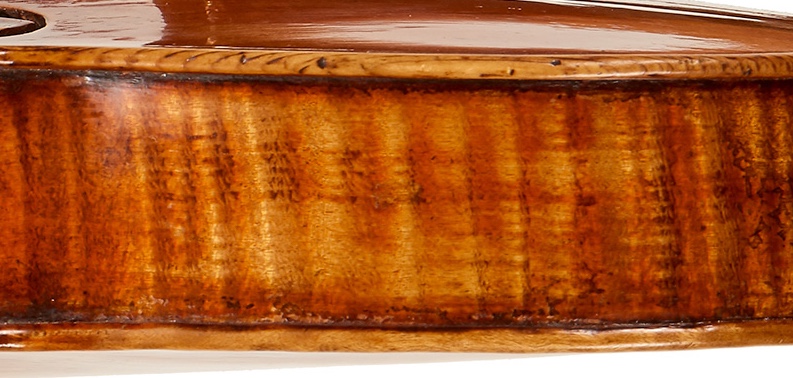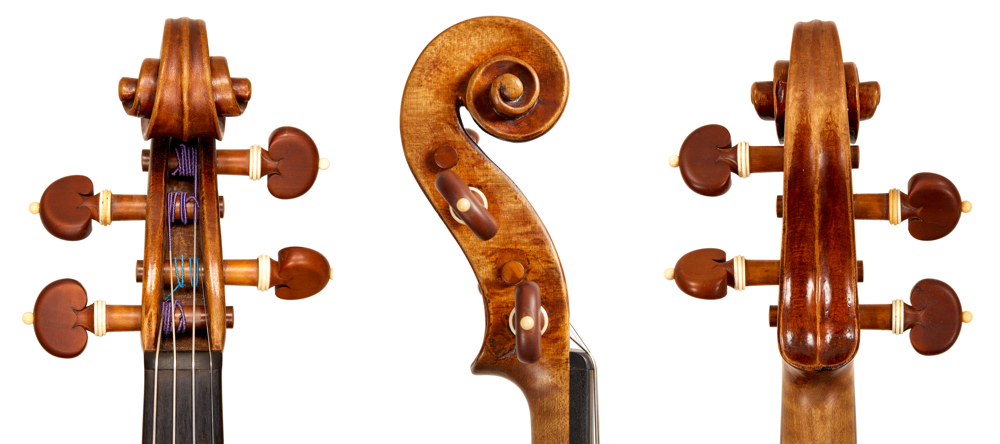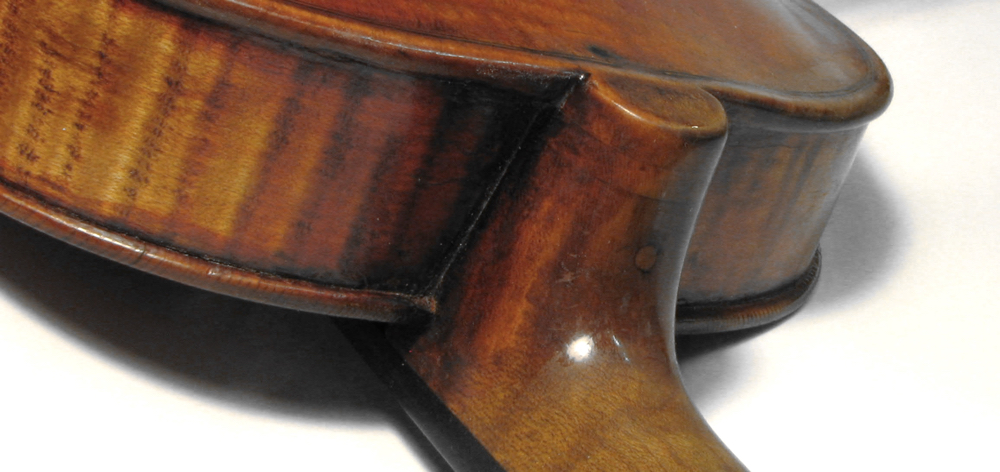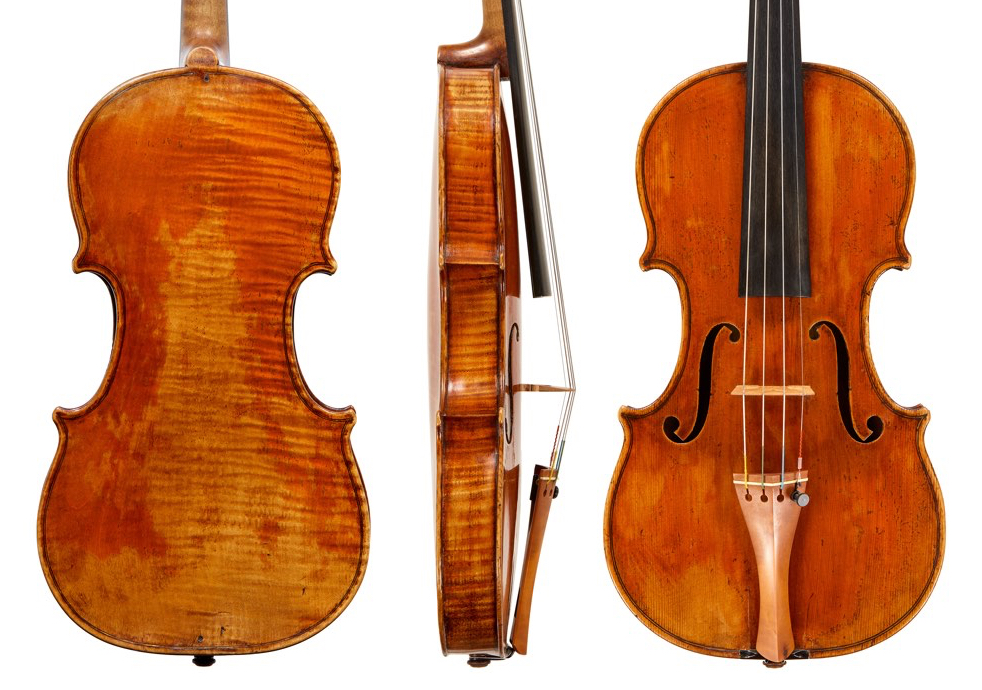In 1771 Giovanni Battista Guadagnini arrived in Turin. Within a few years the maker, who was in his 60s, entered into a contract with the not yet 20-year-old Count Cozio: Cozio was to supply wood and materials, Guadagnini would make instruments according to Cozio’s instructions and the count would buy the resulting instruments at a fixed price. In the following years, with the assistance of Guadagnini, Cozio acquired the tools, forms and remaining instruments of the Stradivari workshop. It was through access to these tools and materials that Guadagnini’s instruments from Turin became more Stradivarian in concept and, consequently, the instruments he made in this last period became his most desirable. The partnership lasted until 1776 and the ‘Lachmann-Schwechter’ Guadagnini of this year was possibly one of the last instruments that Guadagnini made for the count.
The back is formed of a single piece of maple cut partially on the slab with a shallow, horizontal flame that is more prominent on the bass side than the treble. The grain is wide and irregular. The ribs, of maple not matching the back, are cut on the quarter with strong flame and narrow grain. The head is mostly unfigured. The top is formed of two pieces of spruce with extremely narrow and fine grain in the central section, widening considerably at the flanks. The varnish is notably transparent and of an orange-red color with moderate wear.
The model is typical of Guadagnini in Turin, with long C-bouts and slightly higher upper corners in relation to the Cremonese norms. The archings are inspired by late Stradivari – rather low and flat from the center to the edges with hardly any fluting. The corners are wide and thin and of varying length and orientation. The unfussy finishing of the corners betrays the speed with which the violin was made but at the same time shows off the mastery and strength of character typical of Guadagnini instruments from this period.
The external strips of the purfling are dyed a rich and deep black, which was not always the case. The purfling of many instruments from the 1780s were made with a highly fugitive dye that leaves the purfling looking ‘inside-out’. The widths of the purfle strips is varied, with both the white and black strips at times widening and narrowing. The purfling channel is precise and cut in elegant and harmonious curves, terminating in mostly precise mitres at the corners. The edge margin is rather wide, which accentuates the boldness of the outline.
The two locating pins on the back are slightly off-center and roughly a millimeter inside the purfling. On the top as well there is evidence of a filled hole where the locating pin would have been just above the saddle. On the back just under the button the purfling stops for a short stretch. We see a similar treatment on the ‘Moennig’ violin of the same year and there are other violins from this period with replaced purfling under the button as if this section were filled in later.
There have been various theories put forth to explain this: perhaps it was a matter of expediency, as scribing the purfling under the button cannot be done with the same marking tool as the rest of the instrument and requires manual intervention, or perhaps it was to strengthen the area under the button which was prone to breakage. Without a doubt, there was a deliberate reason for this gap in the purfling but no one explanation is particularly convincing. Equally interesting is the observation that even in the violins from this period where the purfling continues under the button, the purfling is shaky and the left- and right-bout curves often connect awkwardly under the button.

Left: the purfling stops for a short section on the back. Right: in violins from this period where the purfling does continue under the button, it is often shaky (clockwise from top left: violins dated 1778, 1772, 1777, 1774, 1776 and 1776)
Guadagnini sound-holes in the 1770s and 80s were greatly influenced by Stradivari, as seen in the generously proportioned and gently flaring lower wings of this instrument. The upper and lower holes are unusually regular and circular, unlike the oval-shaped lower holes typical of his earlier periods.
As is often the case with Guadagnini, the upper corners and the sound-holes themselves are set slightly high in relation to Cremonese norms and consequently the notches are cut slightly lower than the midpoint of the stems to preserve a correct stop length. This has the knock-on effect of further accentuating the impression that the stems of Guadagnini sound-holes are wider in their upper half and more tapered in the lower portion.

The tooth marks left on the ribs suggest that Guadagnini was working in haste
Throughout the instrument there is an abundance of tool-marks that reveal the techniques used in its construction. In the center of the top between the sound-holes, and also in the lower right bouts, we can see marks left from a coarse powdered abrasive or possibly an improvised glass scraper.
On the ribs we see evidence that a toothed blade was used to plane the heavily figured maple before bending it into ribs. Most makers scrape away the furrows left by the teeth of the blade but here Guadagnini, mostly likely working in haste, has left them and under varnish they have become even more apparent.

The model of the scroll is full of character and strength
The model of the scroll is full of character and strength and is cut rather precisely. In the volute we see tool-marks that indicate that the eye of the volute was finished with a gouge cut and not smoothed over with an abrasive. The dorsal side of the scroll, however, is finished to a much smoother standard, suggesting that some sort of abrasive was used. The central ridge is higher in profile than the sides, as is typical of Guadagnini. Traces of the original blackening are still visible on the chamfers, particularly at the throat.

The label has been cut to accommodate the handwritten date and the monogram ‘GBG’ (right)
The label is original and is cut non-rectangularly. The lower right corner of the label has two steps to accommodate first the date, which is handwritten, and second the monogram ‘GBG’ over the letter for ‘T’ for Torino and under a cross with arms of equal length.
This instrument is in an exceptional state of preservation. It has no internal patches and its edges are original and undoubled. The instrument also bears its original neck, which has been re-angled and lengthened slightly at the heel. At the center of the heel a small circular maple inlay fills the hole left by a nail that originally reinforced the joint between the neck and body. The corner blocks, in willow or a similar wood, appear to be the originals.

The original neck has been re-angled and has a filled nail hole
The varnish bears evidence of careful use and, as seen under ultraviolet light, there are abundant areas of original varnish on the back, top, ribs and head. A fine craquel is also evident in several places. It’s easy to appreciate the excellent quality of the pigments Guadagnini used – the resulting varnish has a rich orange color but is transparent and extremely vibrant.
Dimensions
Length of Back: 35.2 cm
Upper Bouts: 16.6 cm
Middle Bouts: 11.3 cm
Lower Bouts: 20.3 cm
Bibliography
Ernest N. Doring, The Guadagnini Family of Violin Makers, Chicago 1949.
Roger Hargrave, The Lachmann-Schwechter Violin, in The Strad, January 1985.
Walter Hamma, Meister Italienischer Geigenbaukunst (8th edition), Wilhelmshaven 1993.
Duane Rosengard, Giovanni Battista Guadagnini, Haddonfield 2000.
Andrea Zanrè (ed), Joannes Baptista Guadagnini, Edizioni Scrollavezza & Zanrè, Parma 2011.
